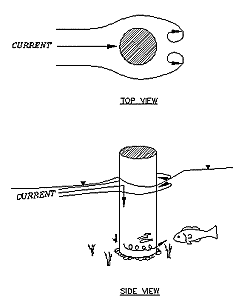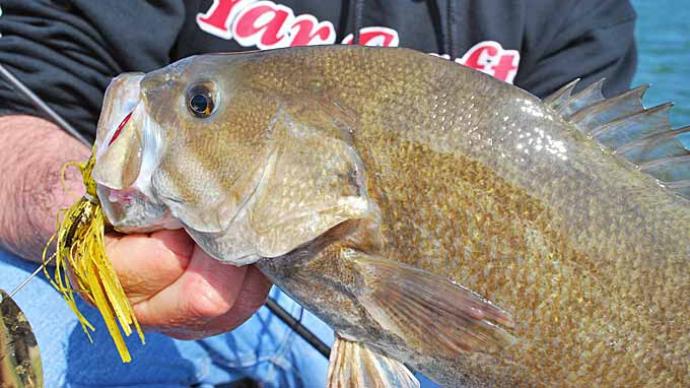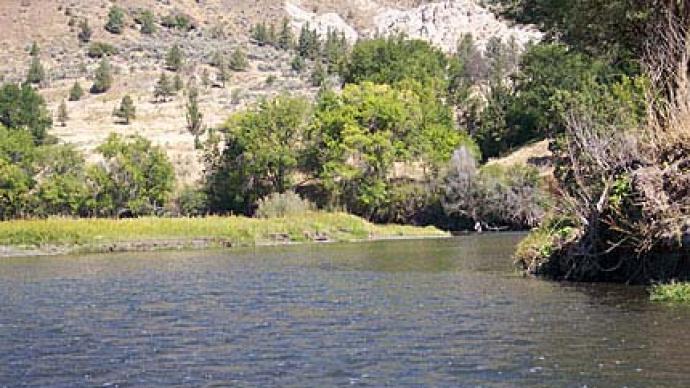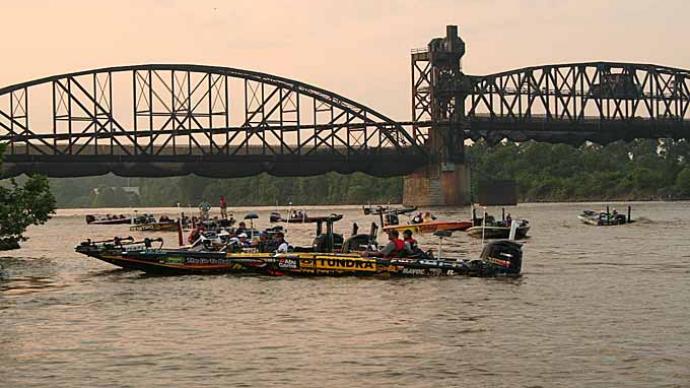The sounds of a rhythmic "bloop - bloop - bloop" resonate in the darkness. A sudden, explosive splash raises just about every hair on the back of my neck. I am not watching a cheap horror movie but fishing under a highway overpass.
Bass holding under bridges is not news to anglers. Many are familiar with their fertile ecosystems and fish-holding capabilities. However, I challenge those anglers to move away from the rip rap banks and describe the bridge-supporting structure beneath the water in detail. Understanding bridge foundation types, angling applications, and seasonal patterns can be the key to selecting the most effective presentation for the structure-minded bass.
For starters, a foundation is a term used to describe all the structural components required to support a bridge deck. Foundations can be grouped into two primary classifications: spread footings and piles. As its root word insinuates, a footing resembles a "foot" placed upon the river or lake bottom. A pile, on the other hand, extends beyond the subsurface to a predetermined depth. Most anglers have seen both foundation types, whether it was consciously recognized or not. From the perspective of the bass, the various foundations represent many habitats.
There is More to a Bridge than Meets the Eye

Spread footings are one of the oldest bridge foundation types. The relative ease of construction has made these foundations commonplace in historical applications. There are a few distinctive characteristics to these supports. A large concrete "base plate" is constructed upon a stable subsurface. That plate is generally rectangular and can extend across the entire width of the bridge deck to support single or multiple piers. Since the spread footing is thick, current breaks are created at the bottom corners of the structure.
Conversely, bridge piles are relatively hydrodynamic in shape. They can be identified as a series of steel cylinders. Piles may not be immediately visible above the water when a group is assembled to create a pier. From above, a pier may look like a single support to the bridge. While below, rows of piles bear the load of the structure. Bridge piles are commonly drilled or driven, and the cylinder is often used as a form for the poured concrete. While a single pile creates less turbulence than spread footings, multiple piles must carry the same loading. This provides additional locations for bass to reside.
Using Current to Your Advantage
Bridges over rivers and streams can simplify the search for bass. Identifying the system's current breaks, or eddies, is the key to narrowing that quest. Look for breaks at the downstream side of the foundation. And recognize that the size of that current break can vary depending on depth. The flow of water along the bottom of a river is slowed due to the resistive drag against the bottom.
Dropping a lure into the specific break can be challenging. Casting upstream and allowing the bait to find its way into the eddy is easier and will place the bait in the strike zone for the greatest amount of time.

When bass are holding near the surface, using a slow-sinking soft plastic jerkbait, such as a Gambler Super Stud, presents an offering the fish cannot refuse. Floating topwater poppers and walking baits can also be maneuvered into the desired areas.
The zone at the base of a bridge foundation can provide additional targets for the bass angler desiring to put more fish in the boat. Popularized by national touring professionals, the drop shot rig is a top choice for effectively presenting lures at the bottom. In this technique, line size plays a critical role. Lines that are too great in diameter will pull the lure out from the current break and away from the fish. To minimize the effect, selecting one with a smaller diameter is not a bad idea; the challenging process of landing a big fish on light line can only occur after it is enticed into a strike. As a second factor, the increased drag accompanying larger lines will make strikes more difficult to detect.
An ultra-sensitive, lightweight rod is paramount when attempting to maintain feel with a lure in current. With the proper equipment, the drop shot can also be effective around bridges where current is not commonplace.
Not all bridges are constructed over rivers or streams. Many will cross over channels separating bays or additional lakes in a chain. Those geographic constrictions can have flow generated by factors other than gravity. The wind is the most recognizable.
A body of water exposed to differential wind speeds creates an "artificial" current. In those situations, bass can be much more aggressive than their current-acclimated counterparts when baitfish are caught off guard. With a spontaneous flow, easy meals are at hand for hungry bass. The temporary current can also occur in opposite directions relatively quickly. When a storm approaches with strong winds, a tidal effect is created under the bridge as water surges from one area into another and recedes to a stable level after the event. In those circumstances, the movement is most prevalent at the top of the water. The wind provides the force that acts upon the water column's top.
Again, surface lures will be effective; however, alternative bottom techniques that cannot be used in rivers are also good choices. For example, the Gambler Giggy Head jig excels in chunk rock and light bite situations. Coupled with a semi-buoyant finesse lure, the jig will stand straight up when it comes into contact with the bottom. In addition, the unique lure keeper extending below the head is also designed for easy weedless rigging and prevents rotational bait fouling during light pick-ups.
Other Bridge Fishing Nuances
Erosion. Aside from providing feeding zones for awaiting bass, current can indirectly create alternative targets for bridge fishermen. Foundation scour is created by the turbulence around a footing. The various wakes created between the foundation and water flow eventually erode the bottom away from the bridge pier. Additional areas for fish to hold are created on both sides and even in front of the foundation due to scour.
Shade. Another factor not to overlook when fishing bridges is shade. The sun's position on the horizon shades different areas around a foundation throughout the day. Bass will use the shade to their advantage in ambushing prey. The presence of shade, or lack thereof, can further refine bridge patterns for the time of day.
Autumn. The fall season brings the migration of both bait fish and bass. Bridges often intersect migration routes through a lake chain or river system. Migration of baitfish can fortify bridge system habitats that may only support a few bass throughout the year. This influx of supplementary forage will attract other bass, often in great numbers. In addition, the seasonal end of the aquatic vegetation life cycle encourages bass to search for temporary habitat before wintering. Chunking spinnerbaits and minnow-mimicking lures are a perfect choice around bridges in the fall.
Rip Rap. Finally, rip rap along the base of a foundation is often overlooked in lieu of the obvious rocky banks leading to the bridge deck itself. Rip Rap is often placed to provide additional protection against erosion at the foundation base. The placement of foundation rock is most common for older bridges and structures that cross natural water flowages. Diving Crankbaits ricocheted off rip rap can elicit reaction strikes where other techniques cannot. Carolina Rigged creature baits and Ugly Otters retrieved upstream can be slid over and presented tightly to the rocks.
Too Simple for Some
The next time you are on the water, don't overlook bridges. As simple as the structures may appear from above, focusing on the structure beneath will give you a decisive advantage when selecting the most effective presentation.




